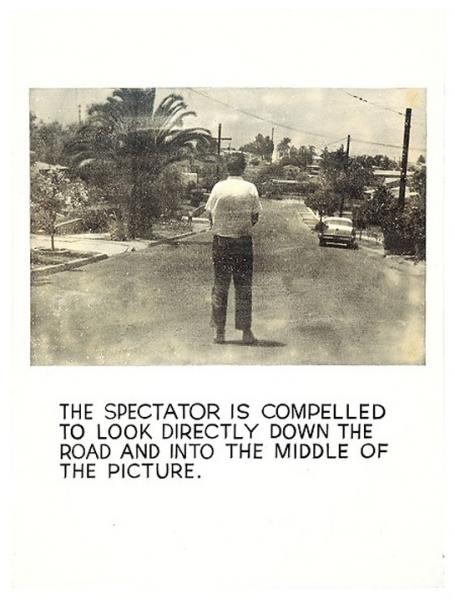Saturday, 7 June 2014
John Baldessari - Wrong
Wrong, 1966-68
John Anthony Baldessari (born June 17, 1931) is an American conceptual artist known for his work featuring found photography and appropriated images. He lives and works in Santa Monica and Venice, California.
Baldessari is best known for works that blend photographic materials (such as film stills), take them out of their original context and rearrange their form, often including the addition of words or sentences. Related to his early text paintings were his Wrong series (1966-1968), which paired photographic images with lines of text from an amateur photography book, aiming at the violation of a set of basic "rules" on snapshot composition.
http://en.wikipedia.org/wiki/John_Baldessari
An Artist is Not Merely the Slavish Announcer, 1966-68
John Baldessari is known for works that blend photographic materials such as film stills. He takes them out of their original context and rearranges their form, often outlining their shapes including the addition of words or short sentences.
The artist made this work between 1966 and 1968. He was intentionally questioning the conventions of picture-making, among other things. The artist created this work after looking at an art instruction book about how to properly compose images. Baldessari had himself photographed in front of a palm tree. He comments: The person that did the book had sketches of the scene, of let’s say a landscape, but there would be two. And one would be right, according to him, and one would be wrong. And I loved the idea that somebody would just say that this is right and this is wrong. So I decided I would have a painting that was wrong, a work of art that was wrong, which seemed right to me.
Baldessari is interested in communicating his concept more than he is in creating something precious or unique. After he decided that his own handwriting was too personal and not distant enough he hired a professional sign painter to letter the word “wrong” you see on the original painting. This poster as a mere reproduction may therefore be undeniably seen as a work of art, though unsigned.
John Baldessari says about his work: I’m very interested in both language and imagery; I don’t really know why, but I find word and image equally important.
http://www.thearchiveislimited.com/john-baldessari-wrong-1966-1968/
The Spectator Is Compelled …, 1966–1968
Aaron Schuman: In your early photo-based work, you took your own photographs and applied them to a canvas. Then you had someone else take pictures of you; then you asked others to take photographs for you; and finally you started to use found imagery, such as film-stills, photos from newspapers, and so on. Why did you gradually take yourself out of the pictures, so to speak?
JB: It was mainly about trying to escape my own good taste, or good taste in general. I think that each time you do some art you get better at it, so I was trying to figure out a way to work against that. Anytime that I could not take a photograph – where I could just give instructions to somebody else to take a photograph – I would do it; if I needed a photograph of a house, I would just tell one of my assistants, ‘Go out and photograph a house.’ Then I would be honor-bound to accept it, because that’s all that I’d asked for. I didn’t say to them what kind of house, or what kind of architecture I wanted – it was just a picture of whatever they thought a house was. I had other ploys too. I’d sit a camera in front of a TV on a tripod, and put an intervalometer on it so that every five minutes it would take a picture, and I would use those photographs. Another thing that I’d do was compose a photograph perfectly using a tripod, and then pick the tripod up, move it a foot, and take the picture. It was all about getting away from good taste.
AS: Why were you intent on avoiding good taste?
JB: Back then, I said that I was trying to work against my own good taste because I figured that good taste is going to come out anyway, no matter what you do, so there’s no reason to work at it.
AS: You’ve often talked about how people such as Marcel Duchamp were deeply influential to you as a young artist, and now you yourself have become an incredibly influential figure in your own right. What’s it like to play such an important role in the lives of other artists?
JB: I think that it’s incredibly flattering to have an effect on other artists. I’ve always seen art as a conversation between artists – I do something that is trying to speak to other artists, and if they’re listening, they do something that tries to speak back to me. It’s kind of like a cocktail party full of artists, but their not talking; they’re making art. I don’t work at trying to influence other artists, but I’m happy that I do, because it means that I’m doing something that’s worthwhile.
http://www.seesawmagazine.com/baldessariinterviewpages/baldessariinterview.html
A Work with Only One Property, 1966
A photo and a word. A four-by-five-foot stretched canvas with a deadpan black-and-white photograph printed on its acrylic surface, showing a lanky westerner standing in front of a palm tree that seems to be growing out of his head, confronted by the single word WRONG neatly lettered below. Critics have come to see this 1967-68 work as John Baldessari`s signature piece and taken it as a laconic gag, one of a series of droll Conceptualist challenges aimed at the compositional standards of conventional photography. This casts Baldessari as a kind of Will Rogers of Conceptual art, and what kind of Conceptualism is that? California Conceptualism, for most of us, who saw it further develop with William Wegman`s loyal Weimaraners, Robert Cumming`s nutty installations, Eleanor Antin`s "ioo BOOTS" 1971-73, and Lowell Darling`s political campaigns. Cartoon Conceptualism, for Joseph Kosuth, who preferred the turgid theorizing of Art 8t Language and his own pedantic prose.
But if Wrong is Baldessari`s signature piece, is it as simple as an arrow directed at a meaning? Another work from around the same time (1967-68) casts doubt on this-a text piece that has lettered on its otherwise blank white ground
A WORK WITH ONLY ONE PROPERTY.
a claim that becomes absurd once you ask yourself what this one property could be, which might be that it`s manifestly false, and then retreat to wonder if, in fact, the text presents a claim at all or merely an invitation to try to imagine a work possessing one property only-and its difficulties. The bluntness of this text`s assertion, if it is an assertion, and its dubiousness connect it directly to Wrong, about which we can reasonably ask, "What`s WRONG?" and answer, "You think you`re looking at a photograph, but it`s a painting." Or, "You think you`re looking at a painting, but it`s a photograph." Or, "You think you`re looking at a provincial artist in a drab little city cracking a joke at his situation." And you`re RIGHT. But you`re also WRONG, because he was employing a cutting-edge art-world strategy for attacking received meaning. So the artist`s ploy of being WRONG for making a photograph and WRONG for making a painting was precisely RIGHT for making the kind of critical art that Conceptual art was claiming to be. It seems like we`re dealing with another form of the Cretan Paradox-in which Epimenides tells you, "All Cretans are liars"; if he`s telling the truth he`s lying, and if he`s lying he`s telling the truth. So Wrong may truly be a signature piece, in that all of Baldessari`s incursions into video, photography, and painting have been very obviously WRONG, because he stumbles as precisely as a silent-era film comedian into the orderly discourses surrounding the genres, leaving the kind of cheerful mess that is usually RIGHT.
David Antin
http://www.mutualart.com/OpenArticle/John-Baldessari/B88EB62D9D43B6BD
Subscribe to:
Post Comments (Atom)





No comments:
Post a Comment